方位介词on,over和above,below和under的用法区别
- 格式:doc
- 大小:27.00 KB
- 文档页数:2

初中语法之方位介词用法如:The book is on the table.书在桌子上。
4.to表示"到达某个地方",强调目的地,不强调是否接壤。
如:We are going to the park.我们要去公园。
5.XXX表示"在。
上方",不强调是否垂直,与below相对。
如:The sun is above the clouds.太阳在云层上方。
6.over表示"在。
上方",强调垂直的上方,与under相对,但over与物体有一定的空间,不直接接触。
如:The plane is flying over the city.飞机在城市上方飞行。
7.on表示"在。
上面",并与之接触。
如:The cup is on the table.杯子在桌子上。
8.under表示"在。
下方",正下方。
如:The cat is under the bed.猫在床下。
9.below表示"在。
下面",不一定在正下方。
如:Please write your name below the line.请在线下方写下你的名字。
XXX is summer。
I love the XXX。
I also like to go XXX。
Summer is a great time to travel and see new things.XXX activities。
I also enjoy reading during the summer。
I like to sit outside and read a book in the sunshine。
It's a great way to relax and unwind。
I usually choose light and easy reads for the summer。
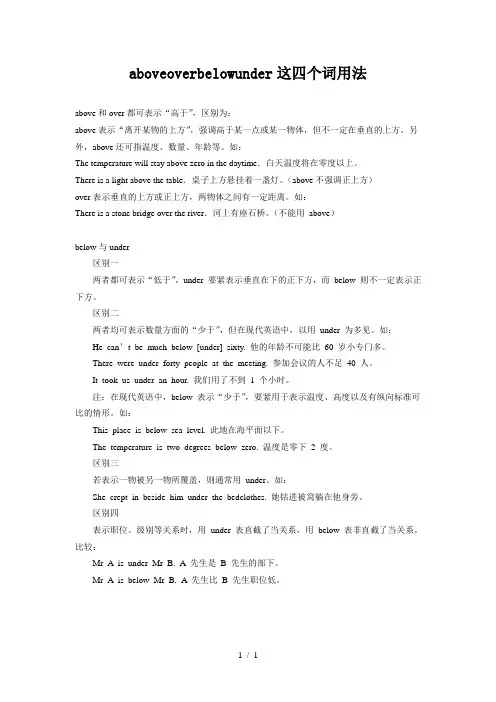
aboveoverbelowunder这四个词用法above和over都可表示“高于”,区别为:above表示“离开某物的上方”,强调高于某一点或某一物体,但不一定在垂直的上方。
另外,above还可指温度、数量、年龄等。
如:The temperature will stay above zero in the daytime.白天温度将在零度以上。
There is a light above the table.桌子上方悬挂着一盏灯。
(above不强调正上方)over表示垂直的上方或正上方,两物体之间有一定距离。
如:There is a stone bridge over the river.河上有座石桥。
(不能用above)below与under区别一两者都可表示“低于”,under 要紧表示垂直在下的正下方,而below 则不一定表示正下方。
区别二两者均可表示数量方面的“少于”,但在现代英语中,以用under 为多见。
如:He can’t be much below [under] sixty. 他的年龄不可能比60 岁小专门多。
There were under forty people at the meeting. 参加会议的人不足40 人。
It took us under an hour. 我们用了不到1 个小时。
注:在现代英语中,below 表示“少于”,要紧用于表示温度、高度以及有纵向标准可比的情形。
如:This place is below sea level. 此地在海平面以下。
The temperature is two degrees below zero. 温度是零下2 度。
区别三若表示一物被另一物所覆盖,则通常用under。
如:She crept in beside him under the bedclothes. 她钻进被窝躺在他身旁。
区别四表示职位、级别等关系时,用under 表直截了当关系,用below 表非直截了当关系。
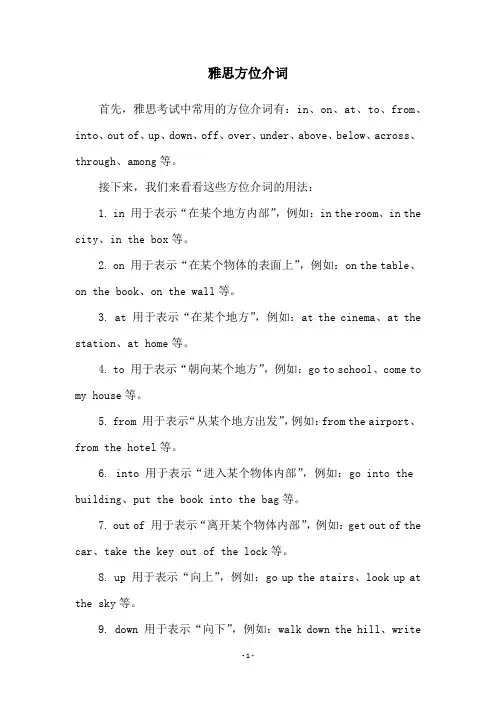
雅思方位介词首先,雅思考试中常用的方位介词有:in、on、at、to、from、into、out of、up、down、off、over、under、above、below、across、through、among等。
接下来,我们来看看这些方位介词的用法:1. in 用于表示“在某个地方内部”,例如:in the room、in the city、in the box等。
2. on 用于表示“在某个物体的表面上”,例如:on the table、on the book、on the wall等。
3. at 用于表示“在某个地方”,例如:at the cinema、at the station、at home等。
4. to 用于表示“朝向某个地方”,例如:go to school、come to my house等。
5. from 用于表示“从某个地方出发”,例如:from the airport、from the hotel等。
6. into 用于表示“进入某个物体内部”,例如:go into the building、put the book into the bag等。
7. out of 用于表示“离开某个物体内部”,例如:get out of the car、take the key out of the lock等。
8. up 用于表示“向上”,例如:go up the stairs、look up at the sky等。
9. down 用于表示“向下”,例如:walk down the hill、writedown the phone number等。
10. off 用于表示“离开某个物体表面”,例如:get off the bus、take the hat off等。
11. over 用于表示“在某个物体之上”,例如:fly over the city、put the blanket over the bed等。
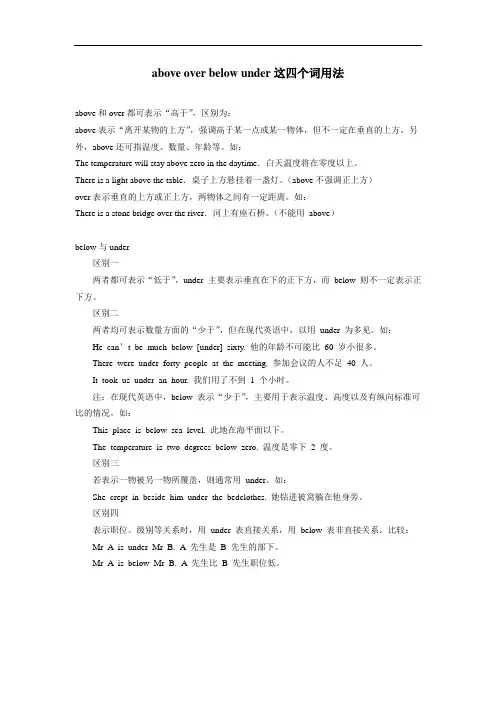
above over below under这四个词用法above和over都可表示“高于”,区别为:above表示“离开某物的上方”,强调高于某一点或某一物体,但不一定在垂直的上方。
另外,above还可指温度、数量、年龄等。
如:The temperature will stay above zero in the daytime.白天温度将在零度以上。
There is a light above the table.桌子上方悬挂着一盏灯。
(above不强调正上方)over表示垂直的上方或正上方,两物体之间有一定距离。
如:There is a stone bridge over the river.河上有座石桥。
(不能用above)below与under区别一两者都可表示“低于”,under 主要表示垂直在下的正下方,而below 则不一定表示正下方。
区别二两者均可表示数量方面的“少于”,但在现代英语中,以用under 为多见。
如:He can’t be much below [under] sixty. 他的年龄不可能比60 岁小很多。
There were under forty people at the meeting. 参加会议的人不足40 人。
It took us under an hour. 我们用了不到1 个小时。
注:在现代英语中,below 表示“少于”,主要用于表示温度、高度以及有纵向标准可比的情况。
如:This place is below sea level. 此地在海平面以下。
The temperature is two degrees below zero. 温度是零下2 度。
区别三若表示一物被另一物所覆盖,则通常用under。
如:She crept in beside him under the bedclothes. 她钻进被窝躺在他身旁。
区别四表示职位、级别等关系时,用under 表直接关系,用below 表非直接关系。
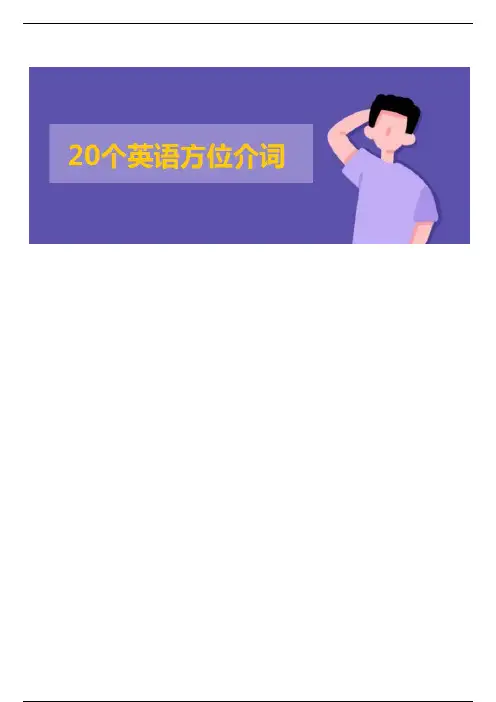
20个英语方位方位介词:in、on、over、under、above、below、by、beside、near 、next to、behind、before、outside、from、among、between等等。
—— 20个英语方位介词及释义 ——方位介词(1):in释义:在……之内例句:The students are reading in the classroom.学生们在教室里读书。
方位介词(2):on释义:在……上面例句:The boat is on the river.那条船在河上。
方位介词(3):over释义:在……(正)上方例句:There are several bridges over the river. 河上有好几座桥。
方位介词(4):under释义:在……(正)下方例句:The boat sailed under the bridge.船在桥下行驶。
方位介词(5):above释义:在……上方例句:The plane flew above the clouds.飞机在云上飞行。
方位介词(6):below释义:在……下方例句:The sun sinks below the horizon.太阳沉没在地平线下。
方位介词(7):by释义:在……旁边例句:Our house is by the river.我们的房子在河边。
方位介词(8):beside释义:Come and sit beside me.过来坐在我旁边。
方位介词(9):near释义:在……附近例句:Idon’t need a car becauseIlive nearthecity centre .我不需要汽车,因为我住在靠近市中心方位介词(10):next to释义:紧挨……例句:My best friend sits next to me in class.上课时我最好的朋友坐在我的旁边。
方位介词(11):behind释义:在……后面例句:Olive hid behind a tree.奥列弗藏在一棵树后面。
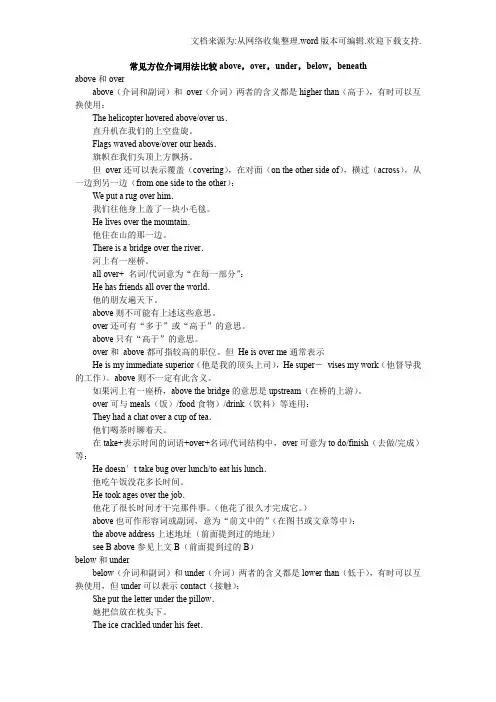
常见方位介词用法比较above,over,under,below,beneathabove和overabove(介词和副词)和over(介词)两者的含义都是higher than(高于),有时可以互换使用:The helicopter hovered above/over us.直升机在我们的上空盘旋。
Flags waved above/over our heads.旗帜在我们头顶上方飘扬。
但over还可以表示覆盖(covering),在对面(on the other side of),横过(across),从一边到另一边(from one side to the other):We put a rug over him.我们往他身上盖了一块小毛毯。
He lives over the mountain.他住在山的那一边。
There is a bridge over the river.河上有一座桥。
all over+ 名词/代词意为“在每一部分”:He has friends all over the world.他的朋友遍天下。
above则不可能有上述这些意思。
over还可有“多于”或“高于”的意思。
above只有“高于”的意思。
over和above都可指较高的职位。
但He is over me通常表示He is my immediate superior(他是我的顶头上司),He super-vises my work(他督导我的工作)。
above则不一定有此含义。
如果河上有一座桥,above the bridge的意思是upstream(在桥的上游)。
over可与meals(饭)/food食物)/drink(饮料)等连用:They had a chat over a cup of tea.他们喝茶时聊着天。
在take+表示时间的词语+over+名词/代词结构中,over可意为to do/finish(去做/完成)等:He doesn′t take bug over lunch/to eat his lunch.他吃午饭没花多长时间。
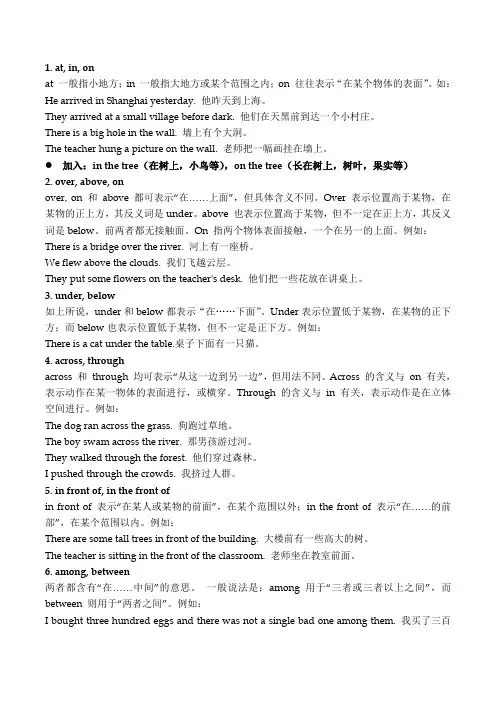
1. at, in, onat 一般指小地方;in 一般指大地方或某个范围之内;on 往往表示“在某个物体的表面”。
如:He arrived in Shanghai yesterday. 他昨天到上海。
They arrived at a small village before dark. 他们在天黑前到达一个小村庄。
There is a big hole in the wall. 墙上有个大洞。
The teacher hung a picture on the wall. 老师把一幅画挂在墙上。
加入:in the tree(在树上,小鸟等),on the tree(长在树上,树叶,果实等)2. over, above, onover, on 和above 都可表示“在……上面”,但具体含义不同。
Over 表示位置高于某物,在某物的正上方,其反义词是under。
above 也表示位置高于某物,但不一定在正上方,其反义词是below。
前两者都无接触面。
On 指两个物体表面接触,一个在另一的上面。
例如:There is a bridge over the river. 河上有一座桥。
We flew above the clouds. 我们飞越云层。
They put some flowers on the teacher's desk. 他们把一些花放在讲桌上。
3. under, below如上所说,under和below都表示“在……下面”。
Under表示位置低于某物,在某物的正下方;而below也表示位置低于某物,但不一定是正下方。
例如:There is a cat under the table.桌子下面有一只猫。
4. across, throughacross 和through 均可表示“从这一边到另一边”,但用法不同。
Across 的含义与on 有关,表示动作在某一物体的表面进行,或横穿。
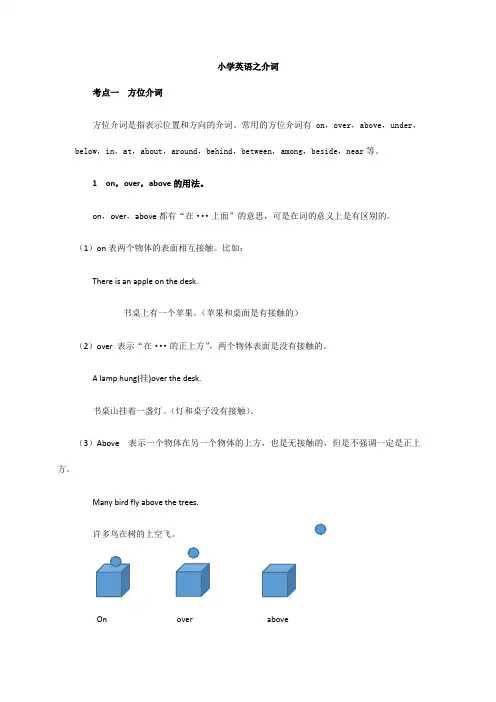
小学英语之介词考点一方位介词方位介词是指表示位置和方向的介词。
常用的方位介词有on,over,above,under,below,in,at,about,around,behind,between,among,beside,near等。
1 on,over,above的用法。
on,over,above都有“在···上面”的意思,可是在词的意义上是有区别的。
(1)on表两个物体的表面相互接触。
比如:There is an apple on the desk.书桌上有一个苹果。
(苹果和桌面是有接触的)(2)over 表示“在···的正上方”,两个物体表面是没有接触的。
A lamp hung(挂)over the desk.书桌山挂着一盏灯。
(灯和桌子没有接触)。
(3)Above 表示一个物体在另一个物体的上方,也是无接触的,但是不强调一定是正上方。
Many bird fly above the trees.许多鸟在树的上空飞。
On over above2 under和below的用法(1)under和below都有“在···的下面”的意思,但是两个词也是有区别的。
Under表示“在···正的下面”。
The cat is under the desk.(2)书桌下面有一只猫。
(强调的是书桌的正下方)below表示“在···的下方”,可是不强调是不是在物体的正下方。
Under below3 in的用法in表示在一个物体的里面My books are in the box.我的书在盒子里。
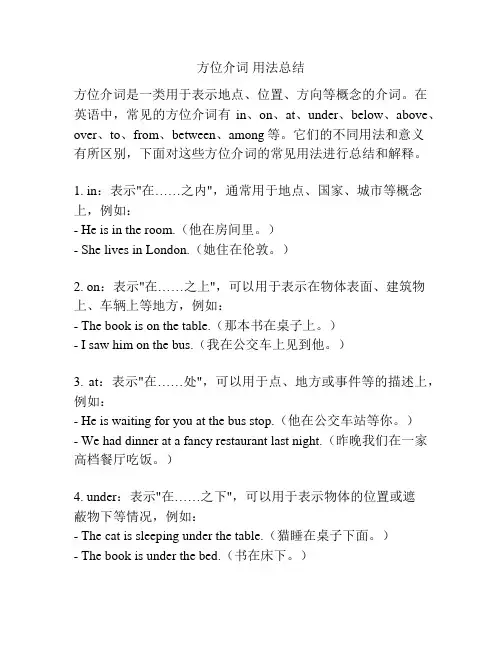
方位介词用法总结方位介词是一类用于表示地点、位置、方向等概念的介词。
在英语中,常见的方位介词有in、on、at、under、below、above、over、to、from、between、among等。
它们的不同用法和意义有所区别,下面对这些方位介词的常见用法进行总结和解释。
1. in:表示"在……之内",通常用于地点、国家、城市等概念上,例如:- He is in the room.(他在房间里。
)- She lives in London.(她住在伦敦。
)2. on:表示"在……之上",可以用于表示在物体表面、建筑物上、车辆上等地方,例如:- The book is on the table.(那本书在桌子上。
)- I saw him on the bus.(我在公交车上见到他。
)3. at:表示"在……处",可以用于点、地方或事件等的描述上,例如:- He is waiting for you at the bus stop.(他在公交车站等你。
)- We had dinner at a fancy restaurant last night.(昨晚我们在一家高档餐厅吃饭。
)4. under:表示"在……之下",可以用于表示物体的位置或遮蔽物下等情况,例如:- The cat is sleeping under the table.(猫睡在桌子下面。
)- The book is under the bed.(书在床下。
)5. below:表示"在……以下",可以用于比较高度、水平或等级等的描述上,例如:- The temperature dropped below freezing last night.(昨晚气温降到了冰点以下。
)- He ranks below his brother in the class.(他在班里的排名在他弟弟之下。
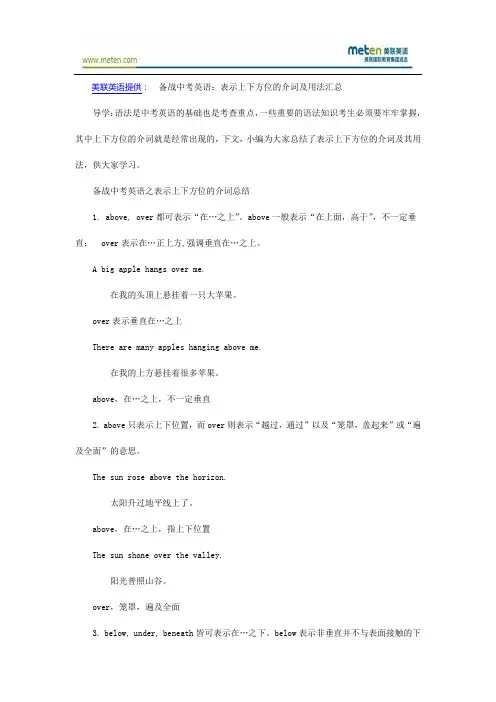
美联英语提供:备战中考英语:表示上下方位的介词及用法汇总导学:语法是中考英语的基础也是考查重点,一些重要的语法知识考生必须要牢牢掌握,其中上下方位的介词就是经常出现的,下文,小编为大家总结了表示上下方位的介词及其用法,供大家学习。
备战中考英语之表示上下方位的介词总结1. above, over都可表示“在…之上”。
above一般表示“在上面,高于”,不一定垂直;over表示在…正上方,强调垂直在…之上。
A big apple hangs over me.在我的头顶上悬挂着一只大苹果。
over表示垂直在…之上There are many apples hanging above me.在我的上方悬挂着很多苹果。
above,在…之上,不一定垂直2. above只表示上下位置,而over则表示“越过,通过”以及“笼罩,盖起来”或“遍及全面”的意思。
The sun rose above the horizon.太阳升过地平线上了。
above,在…之上,指上下位置The sun shone over the valley.阳光普照山谷。
over,笼罩,遍及全面3. below, under, beneath皆可表示在…之下。
below表示非垂直并不与表面接触的下方;under表示垂直并不与表面接触的下方;beneath表示在某物之下,几乎接触或接近。
There is a lake below the mountain.此山下有个湖。
below,在…之下(非垂直)I want to have a rest under the tree.我想在树下休息一会儿。
under表示(垂直)在…之下I found an ant beneath the rock.我在岩石下找到了一只蚂蚁。
beneath,在…之下(几乎接触)4. 总结:above(在…上)与below(在…下)在意义上是相对的,相同点是,两者都表示物体位置上或下不垂直的关系;over(在…上)与under(在…下)在意义上是相对的,相同点是,两者都表示物体位置上或下垂直的关系。
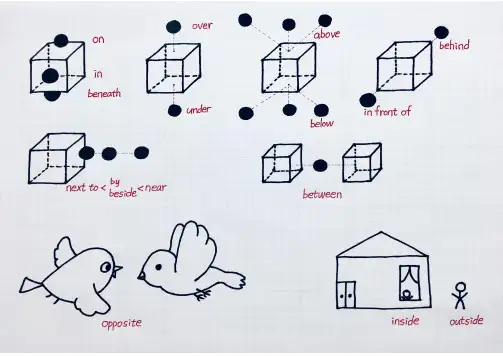
方位介词辨析-Phoebe1.in:表示“在xx的里面,在内部”。
(还表示任何“树上的外来物,小鸟、人,这些原来不长在树上的东西”。
The bird is in the tree.)例:The ball is in the box.There is some sugar in the cupboard.碗柜里有一些糖。
2.on和beneath是相对的:on:表示“在xx的上面”,强调接触面。
(还表示“原来就长在树上的东西,像水果类、果实类”。
The apples are on the tree.)例:The ball is on the box.Leave your things on the table over there.把你的东西放在那边的桌上。
beneath:表示“在xx的底下”,强调接触面。
(不要求掌握)例:The ball is beneath the box.The soil feels soft beneath our feet.我们脚下的土踩上去很松软。
3.over和under是相对的:over:表示“处于xx的正上方”,强调“垂直”的位置。
(over也有覆盖的意思)例:The ball is over the box.A lamp hangs over the table.一盏灯悬挂在桌子上方。
under:表示“处于xx的正下方”,强调“垂直”的位置。
例:The ball is under the box.Phoebe puts the box under her bed.菲比把盒子藏在了床底下。
4.above和below是相对的:above:表示“位置高于某物,但不一定在正上方;可以包含正上方;且不接触另一物”例:The ball is above the box.Our classroom is above the café.我们的教室在咖啡馆楼上。
below:表示“位置低于某物,但不一定在正下方;可以包含正下方;且不接触另一物”例:The ball is below the box.The house is below the clouds.房子在云朵的下方。
方位、地点介词的用法辨析大全易混淆的介词都分门别类好啦!方位介词on, over, above(A) on表示一物放在另一物上面,两者紧贴在一起,如:The book is on the table.(B) over表示一种垂直悬空的上下关系,即“在…上方”,如:Is there any bridge over the river?(C) above表示一般的“高于…”,“在…之上”,不一定在正上方,如:There was an electric clock above his bed.方位介词under,below(A)under是over的反义词即“在…下方”,如:They were seen under the tree.(B)below是above的反义词即“低于…”,“在…之下”,如:They live below us.方位介词across,through,over,past(A) across着重于“从一头或一边到另一头或另一边”,强调从表面穿过。
如:She went across the street to make some purchases.(B) through着重于“穿越”,强调从一定的空间内穿过。
如:The sunlight was coming in through the window.(C)over多表示从“上方越过”,如:He failed to go over the mountain; he had to go round it.(D)past表示从“面前经过”,如:Someone has just gone past the window.方位介词in,on,at(A) in表示“排、行、组”,如:We are in Team One.(B) on表示“左、右”,如:Li Ping is on my left.(C) at表示“前、后”,如:I sit at the front of the classroom.方位介词to,for(A) 介词to表示目的地或去的目的,如:Will you take a train to Tianjin.(B) 介词for表示动身去某地,如:He got on a train for Shanghai.方位介词in front of, in the front of(A) in front of 表示在某人或某物的前面,在某个范围以外。
on表示在一物体上,强调两物相接触,over也表示在一物体上,但强调覆盖这一物体。
试比较:①She put her coat on the bed. 她把大衣放在床上。
②She put her coat over the sleeping baby. 她把大衣盖在那正在睡觉的孩子身上。
③There’s a magazine lying open on the table.桌上有本杂志翻开着。
④There’s a cloth over the table. 桌上摊着一块台布。
⑤The woman lifted a big jar on her head. 那位妇女头上顶着一只大坛子。
⑥She put her hands over her face. 她用手遮住脸。
over表示“越过”某一高度,具有动态之意,on仅表示“处于……之上”,是静态。
试比较:⑦They dragged heavy stones with ropes over their shoulders. 他们肩背绳索拖拽巨石。
(绳在肩膀两边弯下去,不用on。
)To my horror, I saw, over my father’s sho ulder, a gorilla, the worst enemy of the soldier in Africa. 使我感到恐怖的是,从我父亲的肩膀上看过去,我发现非洲士兵最危险的敌人--------一只大猩猩。
(视线越过肩膀后,一直向前方延伸,不用on. )⑨ The farmers walked to their fields with hoes on their shoulders. 农民们肩上扛着锄头,向田地走去。
(仅表示锄头所处的位置。
是静态,用on,不用over. )over和above都可以用来表示“高于”,相当于“higher than”。
例如:① The water came up over/above our knees. 水已涨至我们膝盖之上。
三一文库()/小学一年级〔小学英语语法方位介词辨析[1]〕1. at, in, onat 一般指小地方;in 一般指大地方或某个范围之内;on 往往表示“在某个物体的表面”。
例如:He arrived in Shanghai yesterday. 他昨天到上海。
They arrived at a small village before dark. 他们在天黑前到达一个小村庄。
There is a big hole in the wall. 墙上有个大洞。
The teacher hung a picture on the wall. 老师把一幅画挂在墙上。
2. over, above, onover, on 和 above 都可表示“在……上面”,但具体含义不同。
Over 表示位置高于某物,在某物的正上方,其反义词是under。
above 也表示位置高于某物,但不一定在正上方,其反义词是below。
On 指两个物体表面接触,一个在另一的上面。
例如:There is a bridge over the river. 河上有一座桥。
We flew above the clouds. 我们飞越云层。
They put some flowers on the teacher's desk. 他们把一些花放在讲桌上。
3. across, throughacross 和 through 均可表示“从这一边到另一边”,但用法不同。
Across 的含义与 on 有关,表示动作在某一物体的表面进行。
Through 的含义与 in 有关,表示动作是在三维空间进行。
例如:The dog ran across the grass. 狗跑过草地。
The boy swam across the river. 那男孩游过河。
They walked through the forest. 他们穿过森林。
I pushed through the crowds. 我挤过人群。
英语四个方位词上中下英语方位词有under在下面,above 在上面,below在下面,over在上方,outside在外面等。
1、under 英[ˈʌndə(r)] 美[ˈʌndɚ]prep. 在…下面,在表面之下; 在…的假定表面或掩饰下; 少于,小于; 在…情况下;adv. 在下面; 少于; 在水下; 在昏迷中;adj. 较低的,下面的;[例句]They found a labyrinth of tunnels under the ground.他们发现了一处迷宫似的地道。
2、above 英[əˈbʌv] 美[əˈbʌv]prep. (表示程度)超过; (表示等级)在…之上; (表示位置)在…正上方; (表示比较)优于;adv. 以上; 上述; 在上面;n. 上述;[例句]He lifted his hands above his head.他将双手举过头顶。
3、below 英[bɪˈləʊ] 美[bɪˈloʊ]adv. 在下面,到下面;prep. 低于; (表示位置)在…下面; (表示状态)在…掩饰之下; (表示比较)不及;[例句]He appeared from the apartment directly below Leonard''s.他从伦纳德家正下方的公寓里走了出来。
4、over 英[ˈəʊvə(r)] 美[ˈoʊvə(r)]prep. (表示方向)越过; (部份或全部覆盖)在…上面; 由于; (表示论及)关于;adv. 结束; 再; (倒)下; 从一边至另一边;adj. 过去的; 外面的; 在上的; 上级的;[例句]He looked at himself in the mirror over the table.他对着桌子上方的镜子照了照。
5、outside 英[ˌaʊtˈsaɪd] 美[aʊtˈsaɪd, ˈaʊtˌsaɪd]adv. 在外面; 向外面; 在户外; 露天;n. 外面; (弯曲路面或轨道的)外道; (靠近路中央的)外侧; (建筑物等的)周围;adj. 外部的; 集团外的; (选择余地、可能性等)非常小; 可能性最大的;[例句]Cook over a fairly high heat until the outsides are browned.用大火烹调至表面焦黄。
介词(基础篇)1考点一:方位介词方位介词是表示位置和方向的介词.常用的方位介词有on,over,above,under, below,in,at,about,around,behind,between,among,beside,near等.1.on,over和above的用法on,over和above都有“在…上面”的意思,但这三个调在意义上还是有一些区别的。
(1)on表示两个物体的表面相互接触,例如:There is a plant on the desk.书桌上有一株植物。
(植物紧贴着桌面)(2)over表示“在…的正上方”,两个物体表面没有接触,侧如:A lamp hung over the table.桌子上方挂着一盏灯。
(灯和桌面没有接触)(3)above表示一个物体在另一个的上方,但不一定是在正上方,两个物体之间没有接触。
例如:Look!A lot of birds are flying above the trees.看!许多鸟正在树的上空飞。
2.under和below的用法under和below都有“在…下面”的意思,不过这两个词也是有区别的.(1)under表示“在…的正下方”。
例如:There is a cat under the table.桌子下面有一只猫。
(2)below表示"在…的下面",但不强测是否在正下方,例如:Our classroom is below theirs.我们的教室在他们(教室)的下面。
介词(基础篇)2 3.in的用法in表示"在…里面",也可以用来表示在一个很大的空间内。
例如:There are some books in the box箱子里有一些书。
4.at,about和around的用法at表示"在…旁边",about或around表示"在…周围"。
(1)at表示在某物旁边。
介词:方位介词的用法探讨1. 引言方位介词是用来表示事物之间的空间关系的词语。
在英语中,方位介词主要包括:above, below, behind, below, in front of, near, on, under, between, among等。
本文将对这些介词的用法进行详细探讨。
2. 方位介词的分类2.1 表示垂直关系的介词- Above:表示某物在另一物的上方。
- 例如:The plane was above the clouds.- Below:表示某物在另一物的下方。
- 例如:The fish swam below the surface of the water.- On:表示某物在另一物上方的表面。
- 例如:There is a book on the table.- Under:表示某物在另一物下方的位置。
- 例如:The cat is under the bed.2.2 表示水平关系的介词- Behind:表示某物在另一物的后方。
- 例如:The tree was behind the house.- In front of:表示某物在另一物的前方。
- 例如:The post office is in front of the library.- Near:表示某物在另一物的附近。
- 例如:There is a restaurant near the train station.2.3 表示相邻关系的介词- Between:表示某物在两物之间。
- 例如:There is a lamp between the two chairs.- Among:表示某物在多个物之间,常用于三者或以上。
- 例如:Children are playing among the trees.3. 方位介词的搭配3.1 with搭配某些方位介词可以与with搭配使用,表示某物与另一物具有某种特定的空间关系。
on表示在一物体上,强调两物相接触,
over也表示在一物体上,但强调覆盖这一物体。
试比较:
①She put her coat on the bed. 她把大衣放在床上。
②She put her coat over the sleeping baby. 她把大衣盖在那正在睡觉的孩子身上。
③There’s a magazine lying open on the table.桌上有本杂志翻开着。
④There’s a cloth over the table. 桌上摊着一块台布。
⑤The woman lifted a big jar on her head. 那位妇女头上顶着一只大坛子。
⑥She put her hands over her face. 她用手遮住脸。
over表示“越过”某一高度,具有动态之意,
on仅表示“处于……之上”,是静态。
试比较:
⑦They dragged heavy stones with ropes over their shoulders. 他们肩背绳索拖拽巨石。
(绳在
肩膀两边弯下去,不用on。
)
To my horror, I saw, over my father’s sho ulder, a gorilla, the worst enemy of the soldier in Africa. 使我感到恐怖的是,从我父亲的肩膀上看过去,我发现非洲士兵最危险的敌人--------一只大猩猩。
(视线越过肩膀后,一直向前方延伸,不用on. )
⑨ The farmers walked to their fields with hoes on their shoulders. 农民们肩上扛着锄头,向田地走去。
(仅表示锄头所处的位置。
是静态,用on,不用over. )
over和above都可以用来表示“高于”,相当于“higher than”。
例如:
① The water came up over/above our knees. 水已涨至我们膝盖之上。
② Can you see the birds flying above/over the pear trees? 你看到那一片梨树上空飞翔的鸟吗?▲如果要表示“覆盖”或“越过”,则用over。
如:
③ There’s thick cloud over the south of England. 英格兰南部地区一片乌云。
④ Elect ricity cables went over the fields. 电缆线越过田野。
(这句也可以用across)
▲指数量时,我们一般用over(=more than)表示“超过”,但如果指上下垂直的度量以及海拔高度时,要用above。
试比较:
⑤ You have to be over 18 to see this film. 你得超过十八岁才能看这部电影。
(不用above)
⑥ The temperature is three degrees above zero. 温度在零上三度。
(不用over)
⑦ The mountain is over(=more than)4,000 metres above (higher than) sealevel. 那座山海拔有四千多米高。
▲over表示在某人或某物的正上方,反义词是under。
above表示位置高于某人或某物。
但不一定是正上方,反义词是below.
below与under 区别一两者都可表示“低于”,under 主要表示垂直在下的正下方,而below 则不一定表示正下方(即可以是正下方或非正下方)。
如:Look in the cupboard below [under] the sink. 到洗碗池下面的柜子里找一找。
The climbers stopped 300 meters below the top of the mountain. 登山队员们在离山顶300 米处停了下来。
换句话说,表示正下方,两者都可用;不表示正下方,则通常用below。
区别二两者均可表示数量方面的“少于”,但在现代英语中,以用under 为多见。
如:He can’t be much below [under] sixty. 他的年龄不可能比60 岁小很多。
There were under forty people at the meeting. 参加会议的人不足40 人。
It took us under an hour. 我们用了不到1 个小时。
注:在现代英语中,below 表示“少于”,主要用于表示温度、高度以及有纵向标准可比的情况。
如:This place is below sea level. 此地在海平面以下。
The temperature is two degrees below zero. 温度是零下2 度。
区别三若表示一物被另一物所覆盖,则通常用under。
如:She crept in beside him under the bedclothes. 她钻进被窝躺在他身旁。
区别四表示职位、级别等关系时,用under 表直接关系,用below 表非直接关系。
比较:Mr A is under Mr B. A 先生是B 先生的部下。
Mr A is below Mr B. A 先生比B 先生职位低。